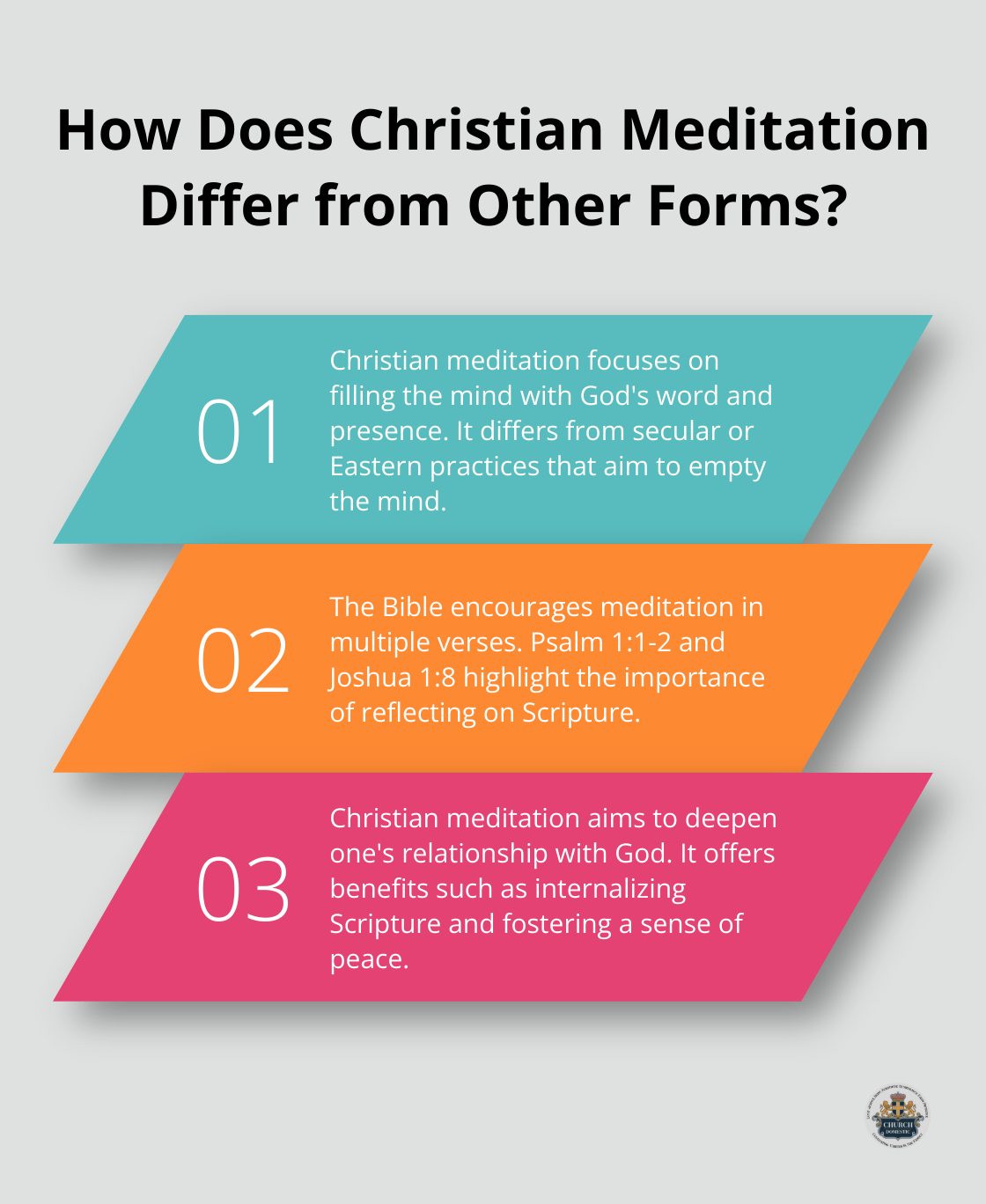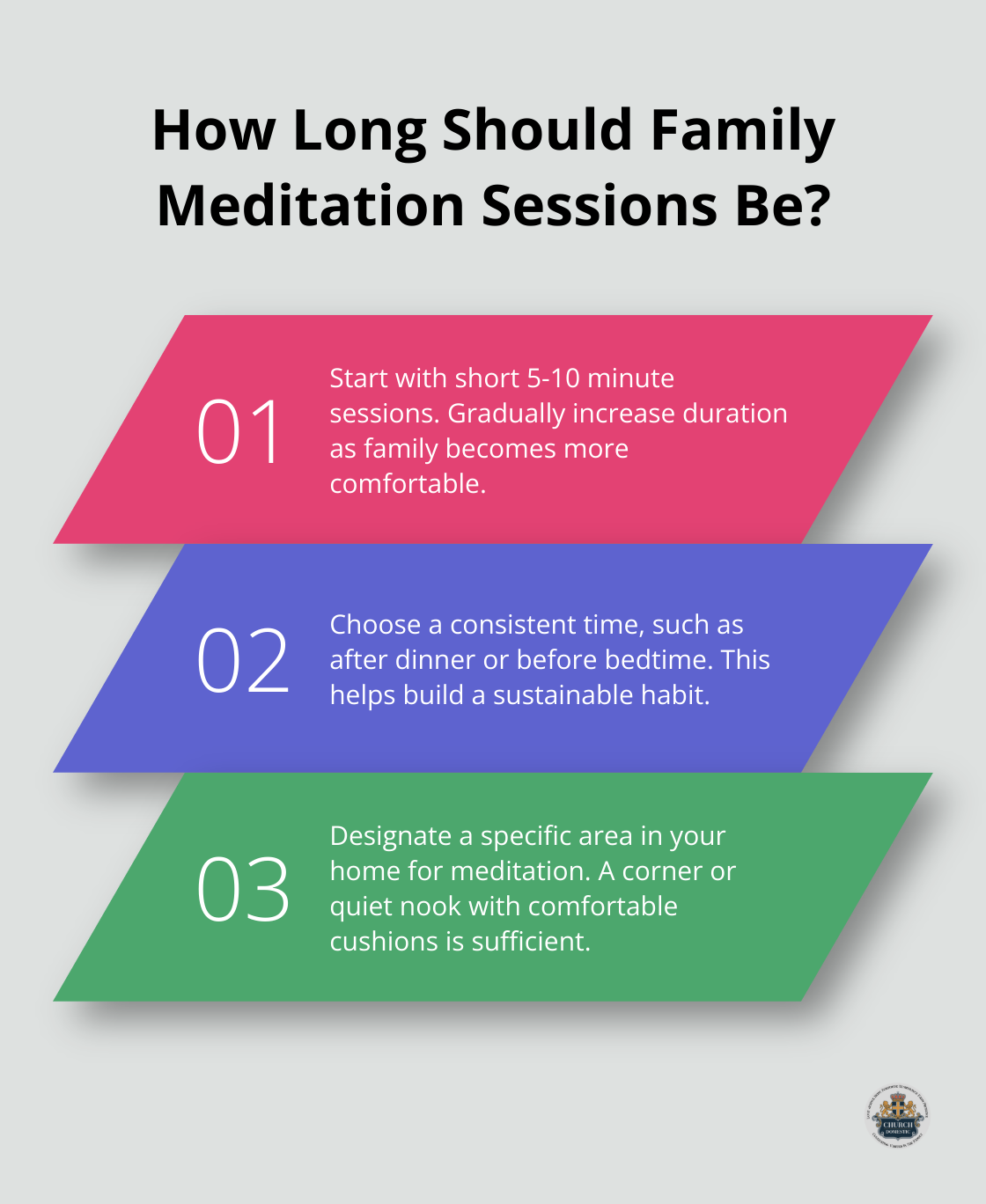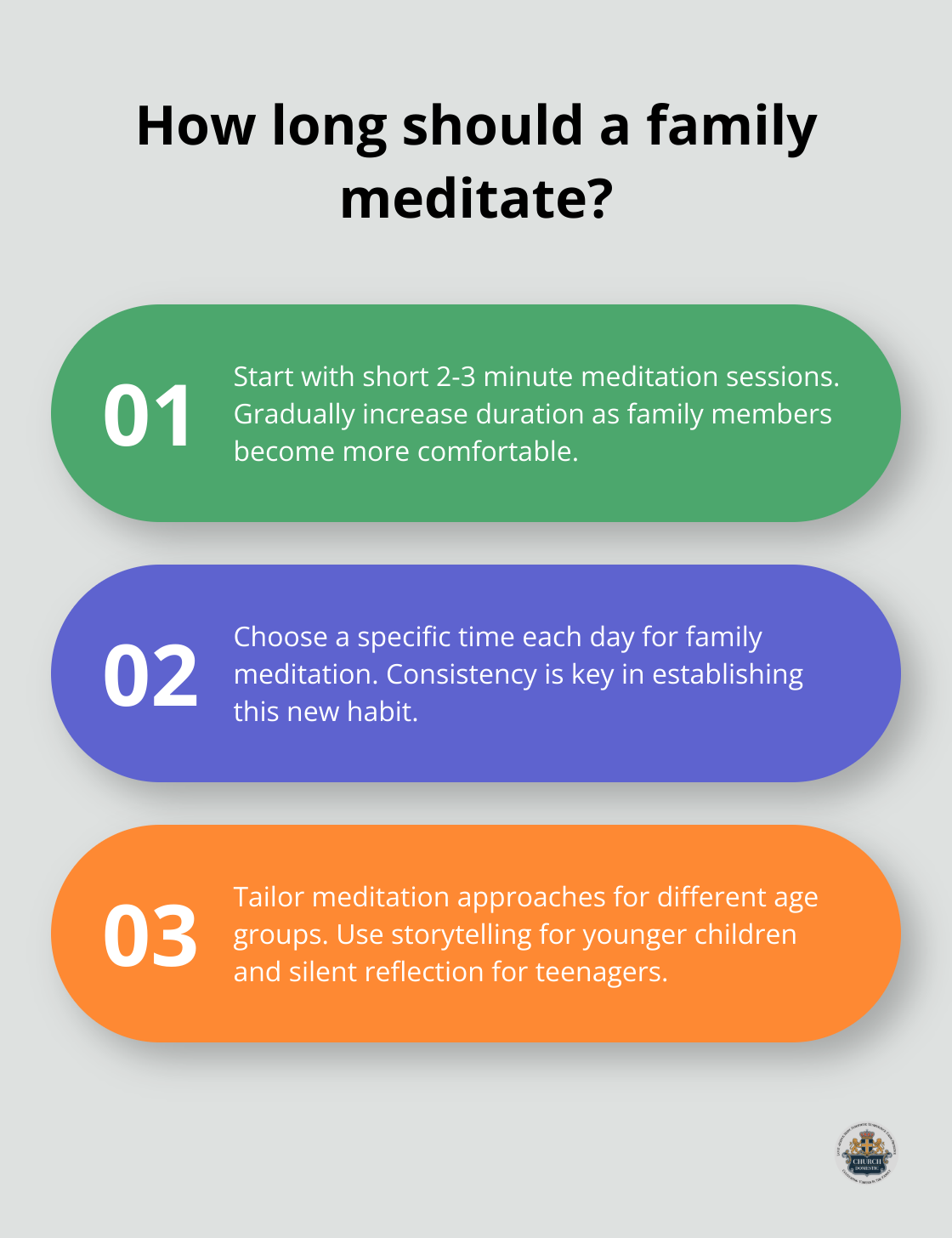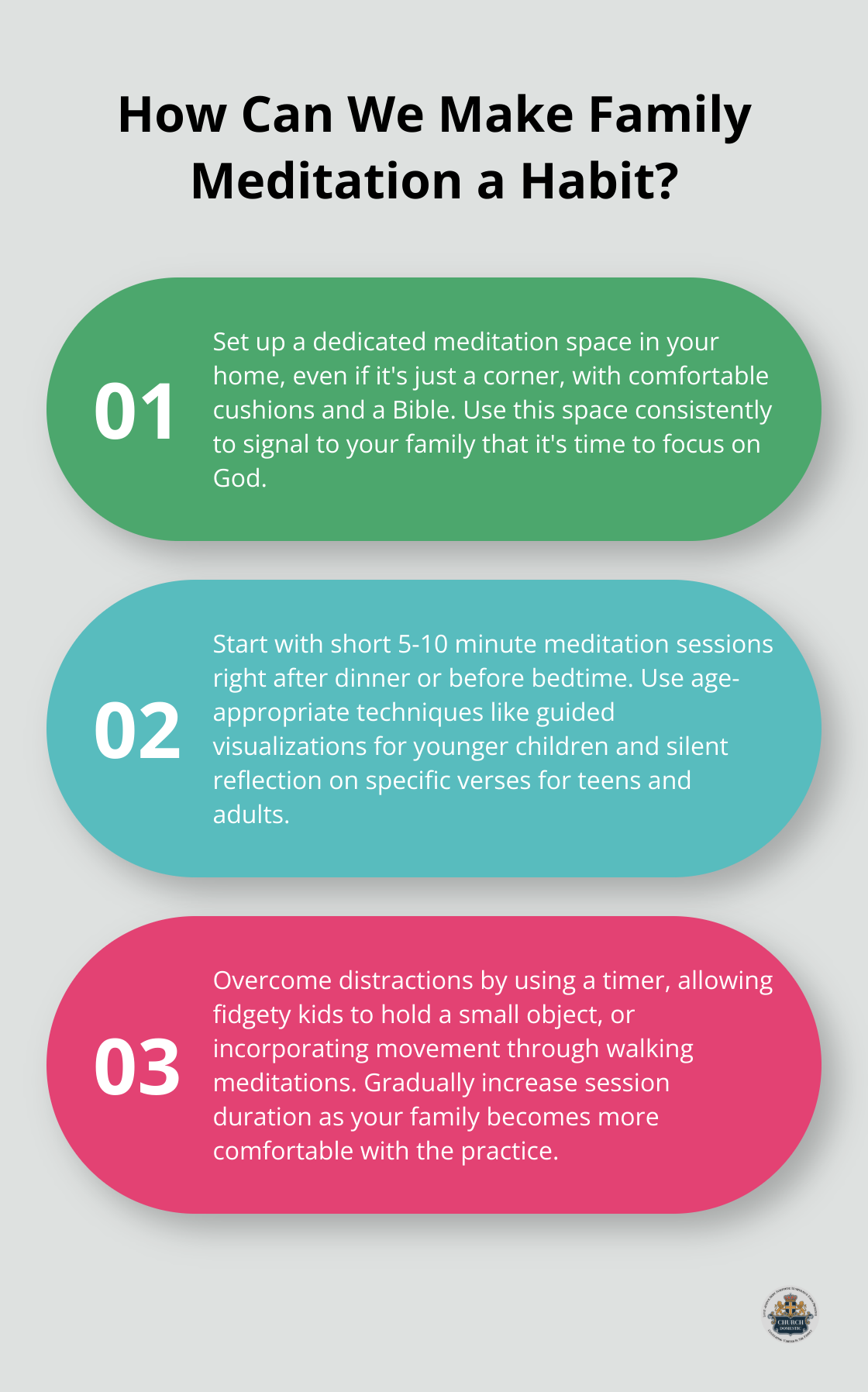At Church Domestic, we believe family meditation can transform your spiritual journey together. This practice, rooted in biblical teachings, offers a powerful way to deepen your faith and strengthen family bonds.
Introducing meditation to your family’s faith routine might seem challenging, but it’s simpler than you think. In this post, we’ll guide you through practical steps to make family meditation a meaningful part of your daily life.
What Is Christian Meditation?
Christian meditation stands as a powerful spiritual practice rooted in biblical teachings. Unlike other forms of meditation that aim to empty the mind, Christian meditation focuses on filling the mind with God’s word and presence.
Biblical Foundations
The Bible encourages meditation throughout its pages. Psalm 1:1-2 states, “Blessed is the one who does not walk in step with the wicked or stand in the way that sinners take or sit in the company of mockers, but whose delight is in the law of the Lord, and who meditates on his law day and night.” Joshua 1:8 instructs us to “keep this Book of the Law always on your lips; meditate on it day and night.” These verses highlight the importance of reflecting deeply on Scripture.
Unique Aspects of Christian Meditation
Christian meditation differs from secular or Eastern practices in its focus. While other forms might emphasize clearing the mind or achieving a state of nothingness, Christian meditation involves active engagement with God’s word and presence. It’s about deepening our relationship with God, not achieving a particular mental state.
Spiritual Growth Benefits
Regular Christian meditation offers numerous benefits for spiritual growth. It helps us internalize Scripture, leading to a deeper understanding of God’s character and will. This practice also fosters a sense of peace and closeness to God, reducing anxiety and stress.

A study published in the Journal of Religion and Health found that individuals who regularly engaged in religious meditation reported higher levels of life satisfaction and lower levels of depression (compared to those who didn’t).
Practical Application
To start incorporating Christian meditation into your family’s routine, begin with short sessions of 5-10 minutes. Choose a quiet time and place, perhaps early morning or before bed. Select a Bible verse or passage to focus on. Read it slowly, repeat key phrases in your mind. Reflect on its meaning and how it applies to your life.
For children, you might use a simple guided meditation based on a Bible story. Encourage them to imagine themselves in the scene, engage their senses to make the experience more vivid and memorable.
Christian meditation is not about achieving perfection but about consistently showing up to spend time with God. As you make this a regular part of your family’s faith practice, you’ll likely notice a deepening of your spiritual lives and a greater sense of God’s presence in your daily activities.
Moving Forward: Introducing Meditation to Your Family
Now that we’ve explored the foundations and benefits of Christian meditation, let’s consider how to introduce this practice to your family. The next section will provide practical steps and strategies to help you create a meaningful meditation routine that resonates with all family members, regardless of age or experience level.
How to Start Family Meditation Today
Set Up Your Sacred Space
Designate a specific area in your home for meditation. This doesn’t require an entire room – a corner of the living room or a quiet nook will suffice. Create an inviting atmosphere with comfortable cushions, a small table for a Bible or devotional materials, and perhaps a candle or two. Consistency is key; using the same space each time signals to your brain that it’s time to focus on God.
Choose the Right Time
Select a time when everyone in the family is usually available and not rushed. For many families, this might be right after dinner or before bedtime. Start with just 5-10 minutes and gradually increase as your family becomes more comfortable with the practice (this gradual approach helps build a sustainable habit).
Age-Appropriate Techniques
For younger children, try guided visualizations based on Bible stories. Ask them to close their eyes and imagine being present in the story as you read it aloud. For teens and adults, silent reflection on a specific verse or passage can be powerful. The Lectio Divina method involves reading a passage slowly multiple times and reflecting on its meaning.
Incorporate Scripture and Prayer
Begin each session by reading a short Bible passage. Select verses that are easy to understand and relate to daily life. After reading, allow a few moments of silence for reflection. End the session with a family prayer, encouraging each member to contribute if they feel comfortable.
Use Technology Wisely
While unplugging during meditation is ideal, some digital tools can help, especially when starting out. Apps that offer guided Christian meditations can provide structure to your family sessions. However, be mindful not to let screens become a distraction from the main goal of connecting with God and each other.

As you embark on this journey of family meditation, you’ll likely encounter some challenges along the way. In the next section, we’ll address common obstacles and provide strategies to overcome them, ensuring your family’s meditation practice remains strong and meaningful.
Navigating Family Meditation Hurdles
Addressing Misconceptions
One of the biggest obstacles in introducing meditation to your family is tackling misconceptions. Some family members might view meditation as incompatible with Christian faith or associate it solely with Eastern religions. To counter this, educate your family about the rich history of Christian meditation. Share Bible verses that encourage meditation, such as Psalm 119:15: “I meditate on your precepts and consider your ways.” Emphasize that Christian meditation focuses on filling the mind with God’s word, not emptying it.
Overcoming Distractions and Restlessness
In our hyper-connected world, sitting still and focusing can challenge many, especially children. To combat this, start with short sessions – even just 2-3 minutes – and gradually increase the duration. Use a timer to provide structure. For fidgety kids, consider allowing them to hold a small object (like a smooth stone or cross) during meditation. This gives them something tangible to focus on.
Incorporate movement into your meditation practice. Try a walking meditation where you slowly walk together in silence, focusing on each step and your breath. This can effectively engage energetic children or teens who struggle with sitting still.
Establishing Consistency
Consistency plays a key role in establishing any new habit, including family meditation. Choose a specific time each day for your practice – perhaps right after dinner or before bedtime. Add it to your family calendar and treat it with the same importance as any other appointment.

Make it fun and engaging. Create a special ritual to signal the start of meditation time, like lighting a candle or ringing a bell. This helps create a positive association with the practice. For younger children, use sticker charts to track participation and offer small rewards for consistent engagement.
Adapting to Different Age Groups
Families often include members of various ages, each with unique needs and attention spans. Tailor your meditation approach to accommodate these differences. For younger children, use storytelling and guided imagery based on Bible stories. Teenagers might prefer silent reflection or journaling. Adults can engage in deeper scriptural study or contemplative prayer. The key is to find methods that resonate with each family member while maintaining a shared experience.
Embracing Imperfection
Perfection isn’t the goal in family meditation. Some days will challenge you more than others. The important thing is to keep showing up and creating space for God in your family’s daily life. Embrace the messiness and unpredictability that comes with family life. These moments often lead to the most meaningful spiritual growth and connection.
Final Thoughts
Family meditation transforms households into sanctuaries of peace and spiritual connection. It provides a foundation for open communication, emotional resilience, and a shared sense of purpose rooted in faith. We at Church Domestic support your family’s spiritual journey with a wealth of resources to help you deepen your meditation practice and strengthen your faith.

Take the first step today and set aside time for family meditation, even if it’s just for a few minutes. You’ll notice how this simple practice impacts your family’s spiritual well-being profoundly. Your journey towards a deeper connection with God and each other starts now.
We offer valuable tools to enrich your family’s spiritual life on our website. Family meditation has the power to create a more vibrant, faith-filled family life (and you’ll be amazed at the results). Start small, be patient, and embrace the challenges as opportunities for growth and learning.